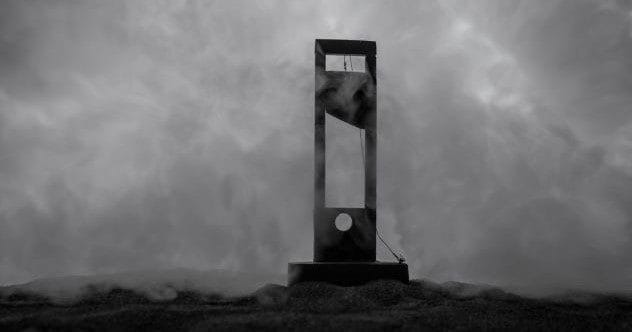History is a treasure trove of fascinating, and sometimes unsettling, stories. We often hear about grand battles, revolutionary ideas, and notorious villains. But what happens when death isn’t the final chapter for some individuals? Believe it or not, there are instances where people have been subjected to execution even after they’ve passed away. These posthumous executions, driven by vengeance, political statement, or sheer animosity, offer a chilling glimpse into the extremes of human nature.
While it sounds like something out of a grim fairytale, executing the dead has happened. It’s a rare occurrence, certainly, but each instance carries a story so bizarre it’s hard to forget. Let’s delve into the accounts of ten individuals who faced judgment and punishment long after they had breathed their last.
10. Pope Formosus
Pope Formosus led the Catholic Church from October 891 to April 896, a time marked by intense political turmoil. His papacy was filled with controversial decisions as various factions fought for control over regions under papal authority. Formosus found himself in the middle of these power struggles, notably opposing Emperor Guy III Spoleto and backing Arnulf of Carinthia, who then seized Rome and became emperor in 895.
After Formosus died in 896, he was buried with full honors. However, his successor, Pope Stephen VI, who ascended in 897, harbored a deep hatred for him. Stephen VI had Formosus’s corpse exhumed and put on trial – an event famously known as the Cadaver Synod. The dead pope, dressed in papal robes, was propped on a throne. Unsurprisingly, he was ‘convicted’ of usurping the papacy. All his acts as pope were annulled. As a final insult, the three fingers Formosus used for blessings were cut off, his body was dressed in rags, reburied, then dug up again, and finally thrown into the Tiber River.
9. Harold Harefoot
Harold I, also known as Harold Harefoot, ruled England from 1035 to 1040. He initially served as regent for his half-brother Harthacnut, who was occupied with a rebellion in Norway. Harold eventually became King of the English in 1037. His reign was characterized by family rivalries and power struggles.
When his stepbrothers, Alfred and Edward, returned to England to challenge him, their efforts were swiftly crushed. Harold Harefoot ruled until his death in 1040. Harthacnut then returned to England and peacefully took the throne. However, Harthacnut was far from pleased with his half-brother’s reign. He ordered Harold’s body to be dug up, beheaded, and thrown into a marsh by the River Thames. Though Harold’s body was later recovered and reburied in London, Harthacnut’s motives likely stemmed from resentment over the crown and possibly blaming Harold for Alfred’s death during his regency.
8. Simon de Montfort, 6th Earl of Leicester
In 13th-century England, Simon de Montfort was a leading figure in the reform movement against his brother-in-law, King Henry III. Their conflict escalated into a civil war. Montfort emerged victorious and, while keeping Henry as king, implemented significant changes. He established the second English parliament, laying groundwork for many democratic norms still seen today. However, it’s important to note Montfort was also known for his harsh persecution of English Jews.
Montfort’s rule was not universally popular and eventually collapsed. This led to the Battle of Evesham in 1265, where Montfort was defeated and killed. But his death wasn’t enough for his enemies. Royalists mutilated his body in a gruesome manner: his head was cut off, and his testicles were hung by his nose. His limbs were sent to his various enemies as trophies, with only his torso receiving a burial.
7. John Wycliffe
John Wycliffe, a 14th-century theologian and Oxford professor, was a key forerunner of the Protestant Reformation, long before Martin Luther. Wycliffe challenged the privileges of the clergy, advocating for apostolic poverty. His followers, known as Lollards, expanded on his ideas, which included predestination and iconoclasm. Crucially, Wycliffe supported translating the Bible into Middle English, an act opposed by many high-ranking Church officials.
Wycliffe died from a stroke in 1384. However, his teachings continued to spread, troubling the Church. Thirty-one years after his death, on May 4, 1415, the Council of Constance declared him a heretic. His writings were banned, and it was ordered that his remains be removed from consecrated ground and burned. This order wasn’t carried out until 1428, a full 44 years after Wycliffe’s death. His ashes were then scattered into the River Swift, though this act did little to halt the spread of his influential ideas.
6. Vlad the Impaler
Vlad III, Voivode of Wallachia, is a significant figure in Romanian history, whose infamous cruelty inspired Bram Stoker’s Dracula. A formidable military leader, Vlad was ruthless. He was known for slaughtering his enemies and impaling captives on spikes, a gruesome practice that earned him his moniker. After refusing to pay homage to Sultan Mehmed II, Vlad fought against the Ottomans. This conflict led to his imprisonment in Hungary from 1463 to 1475.
During his captivity, tales of his brutality spread throughout Europe. After his release, Vlad resumed his fight against the Ottomans and died in battle in late 1476 or early 1477. Even in death, Vlad’s body was not spared. The Turks were so offended by him that they cut his body into pieces. His head was sent to Sultan Mehmed II and displayed on a high stake in Constantinople. The exact location of his final resting place remains a mystery, though it’s believed he was interred at the Comana Monastery.
5. Martin Bucer
Martin Bucer was a dedicated Protestant reformer who joined the movement after meeting Martin Luther in 1518. He worked tirelessly to advance the Reformation, often clashing with the Catholic Church. His marriage to a former nun led to his excommunication, forcing him to flee and join other reformers in Strasbourg, France.
Bucer attempted to bridge the gap between Protestants and Catholics by focusing on areas of agreement, but these efforts were largely unsuccessful. Eventually, he was exiled to England, where he continued his work on the Reformation until his death in Cambridge in February 1551. Unfortunately, his rest was short-lived. When Queen Mary I, known as “Bloody Mary,” came to power, she had Bucer posthumously tried for heresy. His casket was exhumed, and his remains were burned, along with all copies of his writings. Later, Mary’s successor, Queen Elizabeth I, reversed these actions and rehabilitated Bucer’s memory on July 22, 1560.
4. Oliver Cromwell
Oliver Cromwell remains a highly controversial figure in English history. He was a politician, statesman, and a successful military commander who believed his actions were divinely guided. Cromwell played a crucial role in the English Civil War as a Parliamentarian. In 1653, he became Lord Protector of the Commonwealth, a position he held until his death in September 1658.
Cromwell’s death created a power vacuum, leading to the Restoration, which brought Charles II back to the throne. Given that Cromwell had been instrumental in the execution of Charles II’s father, Charles I, this spelled trouble for Cromwell’s earthly remains. King Charles II ordered Cromwell’s body to be exhumed and subjected to a traitor’s execution for regicide. His body was displayed for a time at Tyburn, and his head was removed and placed on a stake outside the Tower of London, where it remained for about three decades. Cromwell’s head was finally reburied in 1960, over 300 years after his death.
3. Edward Teach (Blackbeard)
While the name Edward Teach might not be universally known, his fearsome alias, Blackbeard, certainly is. This notorious pirate operated along the eastern coast of Britain’s North American colonies and in the West Indies during the early 18th century. Commanding his formidable ship, the Queen Anne’s Revenge, which boasted 30 to 40 cannons and a crew of over 300, Blackbeard captured ships, blockaded ports, and ransomed vessels.
His reign of terror eventually caught the attention of Virginia’s governor, Alexander Spotswood, who orchestrated a mission to capture him. Blackbeard was killed in the ensuing battle. Though he couldn’t be captured alive, his body was dealt with posthumously. Robert Maynard, leader of the expedition, had Teach’s head removed and suspended from his ship’s bowsprit. He then presented it to the governor to claim his reward. Blackbeard’s severed head was later displayed on a pole at the entrance of Chesapeake Bay as a grim warning to other pirates.
2. Joseph Warren
Dr. Joseph Warren was one of America’s Founding Fathers and a key figure in the early days of the American Revolution. He dispatched Paul Revere and William Dawes on their famous midnight rides and played a vital role in rallying colonial forces for the Battles of Lexington and Concord. Soon after, Warren was commissioned as a Major General in the colonial army.
However, Warren chose to fight as a private soldier on the front lines rather than command from a distance. This brave but risky decision led to his death at the Battle of Bunker Hill on June 17, 1775, mere days after the Continental Army’s formation. After the battle, British soldiers stripped Warren’s body, bayoneted it beyond recognition, and threw it into a ditch. A few days later, Lieutenant James Drew of the Royal Navy, reportedly dug up Warren’s corpse, spat on it, jumped on it, and then cut off his head, committing further acts of violence upon the body of the fallen patriot.
1. Grigori Rasputin
Grigori Rasputin was a mystic who gained considerable influence over Tsar Nicholas II and his family during the last years of the Russian Empire. He was particularly close to the Tsarina, Alexandra, due to his apparent ability to ease the suffering of their hemophiliac son, Alexei. Many viewed Rasputin as a charlatan and resented his sway over the imperial family. His power grew even more when Nicholas II left to command the Russian army during World War I, further increasing the animosity towards him.
In December 1916, a group of Russian noblemen assassinated Rasputin. The details of his death are shrouded in legend, but his life undoubtedly ended that night. His body was later buried under the supervision of the Imperial family, with plans to build a church over his grave. However, Nicholas II abdicated before this could happen. His successor, Alexander Kerensky, ordered Rasputin’s body to be exhumed and burned to ashes. This act wasn’t necessarily to punish Rasputin further but to prevent his grave from becoming a rallying point for supporters of the old regime.
These stories of posthumous executions are undoubtedly unsettling. They reveal a side of history where vengeance, political statements, or fear extended beyond the grave, reminding us that human actions can sometimes defy even the finality of death. These events, though macabre, serve as powerful testaments to the intense passions and power plays that have shaped our past.
What do you think about these posthumous punishments? Share your thoughts in the comments below!










